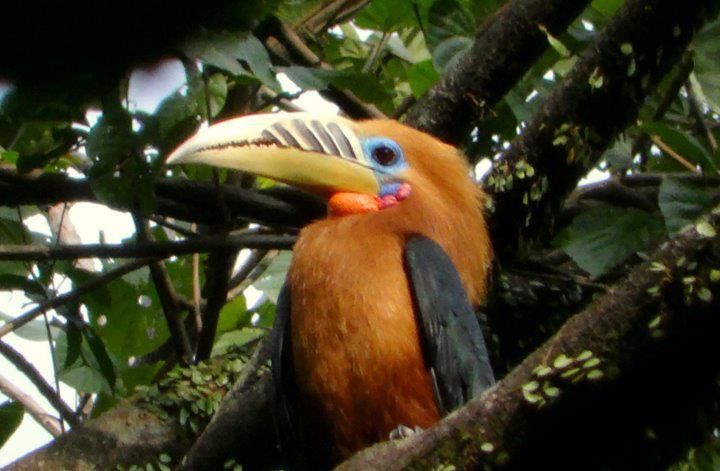| Citation |
|
Description |
Geographic Range [top]
Range Description: Aceros nipalensis is currently known from Bhutan, north-east India, Myanmar, southern Yunnan and south-east Tibet, China, Thailand, Laos and Vietnam. It has declined dramatically and is now very rare across much of its historical range. It is thought to be extinct in Nepal, and to be close to extinction in Vietnam (J. C. Eames in litt. 2007); it has also disappeared from many areas in Thailand. While still widespread and fairly common in Bhutan (K. D. Bishop in litt. 2007), healthy populations elsewhere survive only in Namdapha National Park, India, Nakai-Nam Theun National Biodiversity Conservation Area, central Laos and perhaps also Huai Kha Khaeng, west Thailand, and Xishuangbanna Nature Reserve, China. Population densities in these strongholds have led some to suppose that the species is more widespread and common than field surveys suggest (Kinnaird and OBrien 2007). It is perhaps locally common in north Myanmar, and there are recent records from West Bengal (D. Ghose in litt. 2005) and Eaglenest Wildlife Sanctuary, Arunachal Pradesh, India (Choudhury 2003, Datta 2009).
Countries occurrence:
Native:
Bhutan; China; India; Lao Peoples Democratic Republic; Myanmar; Thailand; Viet Nam
Regionally extinct:
Nepal
Continuing decline in area of occupancy (AOO): Yes
Extreme fluctuations in area of occupancy (AOO): No
Estimated extent of occurrence (EOO) - km2: 285000
Continuing decline in extent of occurrence (EOO): Yes
Extreme fluctuations in extent of occurrence (EOO): No
Number of Locations: 11-100
Continuing decline in number of locations: Unknown
Extreme fluctuations in the number of locations: No
Lower elevation limit (metres): 150
Upper elevation limit (metres): 2200
Range Map: Click here to open the map viewer and explore range.
Population [top]
Population: A population estimate of 2,500-9,999 individuals has been derived from analyses of records and surveys by BirdLife International (2001). This equates to 1,667-6,666 mature individuals, rounded here to 1,500-7,000 mature individuals.
Trend Justification: Across much of its range forest has been cleared at a rapid rate. In combination with intense hunting pressure these processes are suspected to have driven rapid population declines.
Current Population Trend: Decreasing
Additional data:
?Number of mature individuals: 1500-7000 ?Continuing decline of mature individuals: Yes
?Extreme fluctuations: No ?Population severely fragmented: No
?No. of subpopulations: 2-100 ?Continuing decline in subpopulations: Unknown
?Extreme fluctuations in subpopulations: No ?All individuals in one subpopulation: No
Habitat and Ecology [top]
Habitat and Ecology: It inhabits mature broadleaved forests, generally between 600-1,800 m (maximum altitude 2,200 m), but locally down to 150 m. It has also been recorded in dry woodland (K. D. Bishop in litt. 2007). It nests (usually March-June) in tall, wide-girthed trees. Evidence suggests that some populations make seasonal movements between forested areas in response to variations in the abundance of fruiting trees.
Systems: Terrestrial
Continuing decline in area, extent and/or quality of habitat: Yes
Generation Length (years): 19
Movement patterns: Not a Migrant
Threats [top]
Major Threat(s): Its dependence on large trees for feeding and nesting makes it especially susceptible to deforestation and habitat degradation through logging, shifting cultivation and clearance for agriculture. Furthermore, viable populations require vast tracts of forest to survive, exacerbating its susceptibility to habitat fragmentation. These problems are compounded by widespread hunting and trapping for food, and trade in pets and casques.Hunting is the primary threat to the species in Arunachal, India (Datta 2009).
Conservation Actions [top]
Conservation Actions: Conservation Actions Underway
CITES Appendix I and II. The following protected areas support important populations: Xishuangbanna Nature Reserve, China, Thrumshing La National Park, Bhutan, Namdapha National Park, Arunachal Pradesh, India, Nakai-Nam Theun National Biodiversity Conservation Area, Laos, and Um Phang and Maewong National Parks and Huai Kha Khaeng and Thung Yai Wildlife Sanctuaries, Thailand. Field surveys were conducted in Namdapha National Park, Kamlang Wildlife Sanctuary, Jairampur Forest Division and Deomali Forest Division, Arunachal Pradesh, India, during 1996-1999 and 2002-2004 (Datta 2009).
Conservation Actions Proposed
Conduct further surveys to clarify its distribution and status. Monitor trends in selected key populations. Protect remaining extensive tracts of forest, extend existing protected areas where appropriate, and strictly control hunting in protected areas. Lobby for improved logging practices that leave patches of old growth or large trees. Design and implement hornbill conservation programmes aimed at reducing hunting levels.
Citation: BirdLife International. 2012. Aceros nipalensis. The IUCN Red List of Threatened Species 2012: e.T22682510A38016914. . Downloaded on 08 December 2015.
Disclaimer: To make use of this information, please check the .
Feedback: If you see any errors or have any questions or suggestions on what is shown on this page, please provide us with feedback so that we can correct or extend the information provided |

